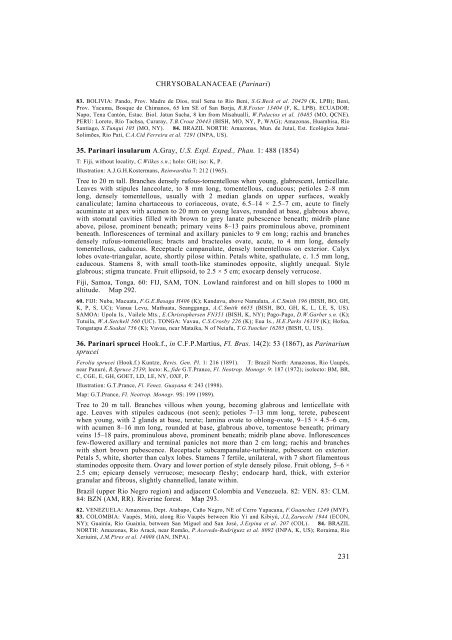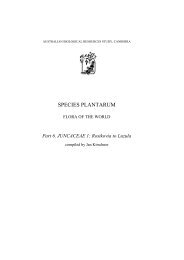Vol. 1 part 2 - Species Plantarum Programme
Vol. 1 part 2 - Species Plantarum Programme
Vol. 1 part 2 - Species Plantarum Programme
You also want an ePaper? Increase the reach of your titles
YUMPU automatically turns print PDFs into web optimized ePapers that Google loves.
CHRYSOBALANACEAE (Parinari)<br />
83. BOLIVIA: Pando, Prov. Madre de Dios, trail Sena to Río Beni, S.G.Beck et al. 20429 (K, LPB); Beni,<br />
Prov. Yacuma, Bosque de Chimanos, 65 km SE of San Borja, R.B.Foster 13404 (F, K, LPB). ECUADOR:<br />
Napo, Tena Cantón, Estac. Biol. Jatun Sacha, 8 km from Misahuallí, W.Palacios et al. 10485 (MO, QCNE).<br />
PERU: Loreto, Río Tachsa, Curaray, T.B.Croat 20443 (BISH, MO, NY, P, WAG); Amazonas, Huambisa, Río<br />
Santiago, S.Tunqui 105 (MO, NY). 84. BRAZIL NORTH: Amazonas, Mun. de Jutaí, Est. Ecológica Jutaí-<br />
Solimões, Rio Patí, C.A.Cid Ferreira et al. 7291 (INPA, US).<br />
35. Parinari insularum A.Gray, U.S. Expl. Exped., Phan. 1: 488 (1854)<br />
T: Fiji, without locality, C.Wilkes s.n.; holo: GH; iso: K, P.<br />
Illustration: A.J.G.H.Kostermans, Reinwardtia 7: 212 (1965).<br />
Tree to 20 m tall. Branches densely rufous-tomentellous when young, glabrescent, lenticellate.<br />
Leaves with stipules lanceolate, to 8 mm long, tomentellous, caducous; petioles 2–8 mm<br />
long, densely tomentellous, usually with 2 median glands on upper surfaces, weakly<br />
canaliculate; lamina chartaceous to coriaceous, ovate, 6.5–14 × 2.5–7 cm, acute to finely<br />
acuminate at apex with acumen to 20 mm on young leaves, rounded at base, glabrous above,<br />
with stomatal cavities filled with brown to grey lanate pubescence beneath; midrib plane<br />
above, pilose, prominent beneath; primary veins 8–13 pairs prominulous above, prominent<br />
beneath. Inflorescences of terminal and axillary panicles to 9 cm long; rachis and branches<br />
densely rufous-tomentellous; bracts and bracteoles ovate, acute, to 4 mm long, densely<br />
tomentellous, caducous. Receptacle campanulate, densely tomentellous on exterior. Calyx<br />
lobes ovate-triangular, acute, shortly pilose within. Petals white, spathulate, c. 1.5 mm long,<br />
caducous. Stamens 8, with small tooth-like staminodes opposite, slightly unequal. Style<br />
glabrous; stigma truncate. Fruit ellipsoid, to 2.5 × 5 cm; exocarp densely verrucose.<br />
Fiji, Samoa, Tonga. 60: FIJ, SAM, TON. Lowland rainforest and on hill slopes to 1000 m<br />
altitude. Map 292.<br />
60. FIJI: Nuba, Macuata, F.G.E.Basaga H406 (K); Kandavu, above Namalata, A.C.Smith 196 (BISH, BO, GH,<br />
K, P, S, UC); Vanua Levu, Mathuata, Seangganga, A.C.Smith 6655 (BISH, BO, GH, K, L, LE, S, US).<br />
SAMOA: Upolu Is., Vailele Mts., E.Christophersen FN351 (BISH, K, NY); Pago-Pago, D.W.Garber s.n. (K);<br />
Tutuila, W.A.Setchell 560 (UC). TONGA: Vavau, C.S.Crosby 226 (K); Eua Is., H.E.Parks 16339 (K); Hofoa,<br />
Tongatapu E.Soakai 756 (K); Vavau, near Mataika, N of Neiafu, T.G.Yuncker 16205 (BISH, U, US).<br />
36. Parinari sprucei Hook.f., in C.F.P.Martius, Fl. Bras. 14(2): 53 (1867), as Parinarium<br />
sprucei<br />
Ferolia sprucei (Hook.f.) Kuntze, Revis. Gen. Pl. 1: 216 (1891). T: Brazil North: Amazonas, Rio Uaupés,<br />
near Panuré, R.Spruce 2539; lecto: K, fide G.T.Prance, Fl. Neotrop. Monogr. 9: 187 (1972); isolecto: BM, BR,<br />
C, CGE, E, GH, GOET, LD, LE, NY, OXF, P.<br />
Illustration: G.T.Prance, Fl. Venez. Guayana 4: 243 (1998).<br />
Map: G.T.Prance, Fl. Neotrop. Monogr. 9S: 199 (1989).<br />
Tree to 20 m tall. Branches villous when young, becoming glabrous and lenticellate with<br />
age. Leaves with stipules caducous (not seen); petioles 7–13 mm long, terete, pubescent<br />
when young, with 2 glands at base, terete; lamina ovate to oblong-ovate, 9–15 × 4.5–6 cm,<br />
with acumen 8–16 mm long, rounded at base, glabrous above, tomentose beneath; primary<br />
veins 15–18 pairs, prominulous above, prominent beneath; midrib plane above. Inflorescences<br />
few-flowered axillary and terminal panicles not more than 2 cm long; rachis and branches<br />
with short brown pubescence. Receptacle subcampanulate-turbinate, pubescent on exterior.<br />
Petals 5, white, shorter than calyx lobes. Stamens 7 fertile, unilateral, with 7 short filamentous<br />
staminodes opposite them. Ovary and lower portion of style densely pilose. Fruit oblong, 5–6 ×<br />
2.5 cm; epicarp densely verrucose; mesocarp fleshy; endocarp hard, thick, with exterior<br />
granular and fibrous, slightly channelled, lanate within.<br />
Brazil (upper Rio Negro region) and adjacent Colombia and Venezuela. 82: VEN. 83: CLM.<br />
84: BZN (AM, RR). Riverine forest. Map 293.<br />
82. VENEZUELA: Amazonas, Dept. Atabapo, Caño Negro, NE of Cerro Yapacana, F.Guanchez 1249 (MYF).<br />
83. COLOMBIA: Vaupés, Mitú, along Rio Vaupés between Río Yí and Kibiyú, J.L.Zarucchi 1944 (ECON,<br />
NY); Guainía, Río Guainía, between San Miguel and San José, J.Espina et al. 207 (COL). 84. BRAZIL<br />
NORTH: Amazonas, Rio Aracá, near Romão, P.Acevedo-Rodriguez et al. 8092 (INPA, K, US); Roraima, Rio<br />
Xeriuini, J.M.Pires et al. 14008 (IAN, INPA).<br />
231












